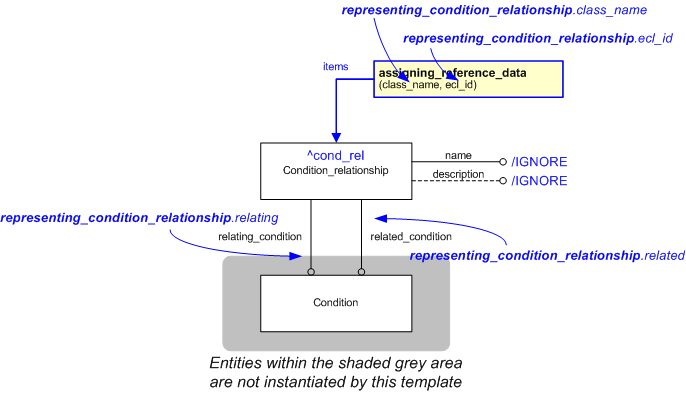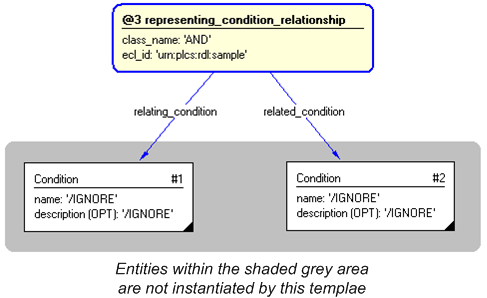Template:— representing_condition_relationship (rep_cond_rel)
Capability:representing_condition |
Date: 2008/02/27 21:47:38
Revision: 1.7
|
This section specifies the template representing_condition_relationship.
NOTE
The template has been defined in the context of the capability
representing_condition
which provides an overall description of the
relevant parts of the ISO 10303-239 information model and a description
of related templates.
NOTE
An explanation of a template and the associated instantiation path is
provided in the
Template overview
section.
This template describes how to represent condition relationships such as logical expressions ('AND', 'OR' etc).
The EXPRESS-G diagram in
Figure
1
shows the templates and EXPRESS entities that are required
to represent the template
"representing_condition_relationship".
The text highlighted in blue shows the template parameters.
Figure 1 — An EXPRESS-G representation of the Information model for representing_condition_relationship
The graphic for the template to be used in other EXPRESS-G diagrams
is shown in Figure
2
below.
Figure 2 — The graphical representation of the representing_condition_relationship template
The following input parameters are defined for this template:
The name of the
External_class used to describe the role of the relationship.
The following classes and their sub-classes can be used:
ecl_id (Default=urn:plcs:rdl:std,Type='URN')
The following reference parameters are defined for this template:
Allow the
Condition_relationship
entity instantiated in this path to be referenced when this template is used.
%^target = $representing_condition_relationship.cond_rel%
The following parameter combinations specify a uniqueness constraint:
Unique constraint: Unique Condition Relationship
Each instance of the
entity
(
Condition_relationship)
within the data set shall be uniquely identified
by a combination of the following parameters on this
template (representing_condition_relationship) namely:
class_name,
ecl_id,
relating,
related.
The
instance is
referenced by the following template parameter:
cond_rel.
The instantiation path shown below specifies the entities that are to be
instantiated by the template.
A description of templates and the syntax for the instantiation path is
provided in the
Templates Help/Information section.
The following entities are instantiated with attributes as specified:
The instance diagram in Figure
3
shows an example of the EXPRESS entities and templates that are instantiated by the template:
/representing_condition_relationship(relating='#1', related='#2', class_name='AND', ecl_id='urn:plcs:rdl:sample')/
(an illustration of the consolidated representing_condition_relationship template is shown in
Figure
4 below.)
Figure 3 — Entities instantiated by representing_condition_relationship template
The instance diagram in
Figure
4
shows the graphic symbol for the template that is to be
used in other instance diagrams. The example template is:
/representing_condition_relationship(relating='#1', related='#2', class_name='AND', ecl_id='urn:plcs:rdl:sample')/
Figure 4 — Instantiation of representing_condition_relationship template
Characterizations
No common characterizations of the template
representing_condition_relationship
have been identified. However, the ISO 10303-239 EXPRESS model
may enable other assignments to the entities instantiated by the template.




